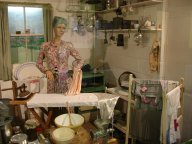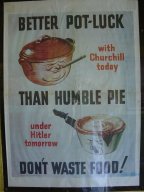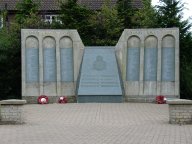 Located near Tattershall Thorpe, not far from Woodhall Spa in rural
Lincolnshire, Thorpe Camp, a handful of huts, is all that remains of the former RAF Woodhall Spa.
Located near Tattershall Thorpe, not far from Woodhall Spa in rural
Lincolnshire, Thorpe Camp, a handful of huts, is all that remains of the former RAF Woodhall Spa.
 Located near Tattershall Thorpe, not far from Woodhall Spa in rural
Lincolnshire, Thorpe Camp, a handful of huts, is all that remains of the former RAF Woodhall Spa.
Located near Tattershall Thorpe, not far from Woodhall Spa in rural
Lincolnshire, Thorpe Camp, a handful of huts, is all that remains of the former RAF Woodhall Spa.
During the latter days of WWII (January 1944 - June 1945), 617 Squadron, the famous Dambusters, was based at RAF Woodhall Spa.
Now all that remains is a handful of huts, but within those huts exhibits of Bomber Command during WWII. Pride of place being to the Dambusters raid and the successful attack on the German battleship the Tirpitz.
The site also has exhibits on life on the home front during WWII.
Thorpe Camp was only intended to be a temporary camp, the buildings a life-span of ten years. Fifty years on, and the buildings are still there.
RAF Woodhall Spa became operational February 1942. Based at Woodhall Spa were 97, 617 (Dambusters), 619 and 627 Squadrons.
 97 Squadron relocated to RAF Woodhall Spa from RAF Coningsby March 1942. They were the second squadron to take delivery of the Avro Lancaster.
97 Squadron relocated to RAF Woodhall Spa from RAF Coningsby March 1942. They were the second squadron to take delivery of the Avro Lancaster.
The first squadron to take delivery of Lancasters was 44 Squadron based at RAF Waddington.
Together with 44 Squadron, 97 Squadron took part in the daring daylight raid on the submarine diesel engine plant at Augsburg in southern Germany on 17 April 1942. This was the first major operational sortie that Lancasters took part in. Of the 12 Lancasters that took part in the raid, only 5 returned. Squadron Leader John Nettleton who led the raid was awarded the Victoria Cross.
617 Squadron operated from the airfield until the end of hostilities, pioneering the use of ultra-heavy bombs - the 12,000lb Tallboy and 22,000lb Grand Slam - both of which were used on special targets in operations from the airfield. As with the bouncing bomb, both Tallboy and Grand Slam were designed by Barnes Wallis.
With the end of the war in Europe the airfield was used as an assembly and kitting-out point for ground personnel for Tiger Force, the planned heavy bomber force for the Far East. After VJ-Day Tiger Force was dispersed, and with 627 Squadron disbanded and with 617 Squadron relocating to RAF Waddington, the airfield was closed. In the years that followed the site was used by 92 MSU for the storage of bombs.
From the late 1950s to 1965 Woodhall Spa became a base for Bloodhound SAM missiles, with what was left of the airfield sold off for agriculture or mineral extraction. The former missile site remained under the control of RAF Coningsby and was used for the servicing of Tornado engines until 2003 when it was mothballed.
The Woodland Trust bought Carr Wood and this included the site occupied by the buildings. The buildings were due to be demolished, but a dedicated band of enthusiasts led by Mike Hodgson set up the Thorpe Camp Preservation Group and persuaded the Woodland Trust to lease, and then subsequently sell the site and the buildings to the group.
Their aim was, and still is, to restore the site and create a Visitor Centre depicting the story of RAF Woodhall Spa and its squadrons, and civilian life in Lincolnshire during WWII.
The full story of RAF Woodhall Spa is told in the book Into Thin Air written by Nigel Press, available from Thorpe Camp.
In the centre of Woodhall Spa is a War Memorial dedicated to 617 Squadron.
The Blue Bell Inn at Tattershall Thorpe, an ancient roadside inn, in addition to serving excellent ales and food, has Dambusters connections. The ceiling of the inn has signatures from members of 617 Squadron.
Nearby, at the former RAF East Kirkby, is the
Lincolnshire Aviation Heritage Centre. The site has a restored WWII Control Tower, a Spitfire and a Lancaster, recovered crashed aircraft, and a large number of exhibits, including the Dambusters raid and the sinking of the Tirpitz.
Also not far away is RAF Coningsby. Still an operational base, the base is home to the Battle of Britain Memorial Flight – a Lancaster escorted by a Spitfire and a Hurricane.
 Petwood Hotel, at Woodhall Spa, was requisitioned in the latter days of WWII as the Officers Mess for 617 Squadron. The Squadron Bar at Petwood is dedicated to 617 Squadron and has memorabilia from the period.
Petwood Hotel, at Woodhall Spa, was requisitioned in the latter days of WWII as the Officers Mess for 617 Squadron. The Squadron Bar at Petwood is dedicated to 617 Squadron and has memorabilia from the period.